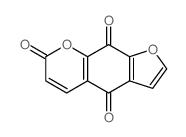482-44-0
| Name | imperatorin |
|---|---|
| Synonyms |
Pentosalen
Imperatorin Enoxypsoralen MFCD00016881 MARMELOSIN AMMIDIN 9-[(3-Methyl-2-buten-1-yl)oxy]-7H-furo[3,2-g]chromen-7-one Marmelide 8-ISOAMYLEN 9-[(3-Methyl-2-buten-1-yl)oxy]-7H-furo[3,2-g]chromen-7-on EINECS 207-581-1 |
| Description | Imperatorin is an effective of NO synthesis inhibitor (IC50=9.2 μmol), which also is a BChE inhibitor (IC50=31.4 μmol). Imperatorin is a weak agonist of TRPV1 with EC50 of 12.6±3.2 μM. |
|---|---|
| Related Catalog | |
| Target |
IC50: 9.2 μmol (NO synthesis), 31.4 μmol (BChE)[1]EC50: 12.6±3.2 μM (TRPV1)[2] |
| In Vitro | Imperatorin is a plant secondary metabolite belonging to the coumarins-specifically the furanocoumarins. Imperatorin enhances the GABA-induced chloride ion current (IGABA) through the α1β2γ2S receptors. Imperatorin potentiates IGABA at 100 μmol by 50.5±16.3 % and at 300 μmol by 109.8±37.7 %, respectively. Imperatorin, together with Phellopterin, found in the roots of A. dahurica, inhibit [3H]diazepam binding to the benzodiazepine site of the rat brain GABAA receptor in vitro with an IC50 of 12.3 μmol for Imperatorin and 400 nmol for Phellopterin. Imperatorin, in a concentration ranging from 3.5 to 14 mmol, significantly and irreversibly inhibits GABA-T in a time-dependent and concentration-dependent manner, by irreversibly binding with the active site of GABA-T.Imperatorin is a reversible acetylcholinesterase (AChE) inhibitor, and acts in dose-dependent manner. The AChE and BChE inhibitory activities of Imperatorin and a crude extract from the fruits of Angelica archangelica L. is tested by the spectrophotometric method at concentrations of 12.5, 25, 50, and 100 μg/mL. Imperatorin displays low inhibition towards AChE (13.75-46.11 %), whereas it has remarkable inhibitory effect against BChE (37.46-83.98 %). Imperatorin shows selectivity toward BChE rather than AChE, with an IC50 for BChE of 31.4 μmol. Imperatorin, together with (+)-Byakangelicol, are found to be the most effective BACE-1 inhibitors, with IC50s of 91.8 and 104.9 μmol, respectively. Imperatorin (IC50=9.2 μmol) is also effective as an inhibitor of NO synthesis[1]. Imperatorin is a weak agonist of TRPV1, a channel implicated in detecting several noxious stimuli, exhibiting EC50 of 12.6±3.2 μM[2]. |
| In Vivo | At doses of 10 and 20 mg/kg and 30 min after injection, Imperatorin shows an anxiolytic effect and improved different stages of memory and learning processes-both acquisition and consolidation. It is also shown that acute administration Imperatorin at doses of 10 and 20 mg/kg reduced the anxiogenic effect of nicotine (0.1 mg/kg, subcutaneous, s.c.). At 30 and 40 mg/kg, i.p. Imperatorin significantly potentiates the anticonvulsant activity of carbamazepine against maximal electroshock-induced seizures expressed by lowering the ED50 from 10.8 to 6.8 mg/kg (by 34 %) and 6 mg/kg (by 42 %), respectively. Moreover, Imperatorin at 30 mg/kg and carbamazepine at 6.8 mg/kg shows increases the total brain concentration of carbamazepine from 1.260 to 2.328 μg/mL (by 85%), which may be caused by modifying the blood-barrier permeability or acting like an inhibitor of multi-drug resistance proteins[1]. Imperatorin, a naturally occurring furanocoumarin, inactivates gamma-aminobutyric acid transaminase and inhibits acetylcholinesterase activity. Imperatorin administered acutely at the doses of 5 and 10 mg/kg prior to the injection of scopolamine (1 mg/kg) improves memory acquisition and consolidation impaired by scopolamine. Furthermore, repeatable (7 days, twice daily) administration of the highest dose of Imperatorin (10 mg/kg) significantly attenuates the effects of scopolamine on memory acquisition, whereas the doses of 5 and 10 mg/kg of this furanocoumarin are effective when memory consolidation is measured [3]. |
| Animal Admin | Mice[3] The experiments are carried out on naive male Swiss mice weighing 20-25 g. Drugs are administered intraperitoneally (i.p.) at the volume of 10 mL/kg. Fresh drug solutions are prepared on each day of experimentation. Control groups receive saline injections of the same volume and via the same route of administration. During the acute treatment, the animals are allocated to the following drug groups: saline, rivastigmine (0.5 mg/kg, i.p.), scopolamine (1 mg/kg, i.p.), Imperatorin (1, 5, 10 mg/kg, i.p.), or Imperatorin coadministered with scopolamine. To measure the memory acquisition processes, scopolamine is administered 20 min before the pretest, whereas Imperatorin and rivastigmine are administered 30 min before the pretest. To measure the memory consolidation processes, rivastigmine or scopolamine (1 mg/kg) is administered immediately after the pretest, whereas Imperatorin is administered 15 min after pretest or after scopolamine injection. On the second day, the mice are retested. In the second set of the experiments, animals are randomly allocated to receive 6 days of i.p. injections of Imperatorin (1, 5, and 10 mg/kg, i.p.) or saline, twice daily (8:00 a.m. and 8:00 p.m.). On the seventh day, these animals are subjected to saline, scopolamine (1 mg/kg, i.p.), Imperatorin (1, 5, and 10 mg/kg, i.p.), or Imperatorin coadministered with scopolamine. To measure the memory acquisition processes, scopolamine is administered 20 min before the pretest and Imperatorin 30 min before the pretest. To measure the memory consolidation processes, scopolamine (1 mg/kg) is administered immediately after the pretest, whereas Imperatorin is administered 15 min after the pretest or after scopolamine injection. On the eighth day, the mice are retested. |
| References |
| Density | 1.2±0.1 g/cm3 |
|---|---|
| Boiling Point | 448.3±45.0 °C at 760 mmHg |
| Melting Point | 98-100ºC |
| Molecular Formula | C16H14O4 |
| Molecular Weight | 270.280 |
| Flash Point | 224.9±28.7 °C |
| Exact Mass | 270.089203 |
| PSA | 52.58000 |
| LogP | 3.81 |
| Vapour Pressure | 0.0±1.1 mmHg at 25°C |
| Index of Refraction | 1.606 |
| Storage condition | 2-8°C |
|
Section1. IDENTIFICATION OF THE SUBSTANCE/MIXTURE Product name: Imperatorin Section2. HAZARDS IDENTIFICATION Classification of the substance or mixture Not a dangerous substance according to GHS. This substance is not classified as dangerous according to Directive 67/548/EEC.
Label elements
The product does not need to be labelled in accordance with EC directives or respective national laws. Other hazards - none Section3. COMPOSITION/INFORMATION ON INGREDIENTS Synonyms: 9-[(3-Methyl-2-buten-1-yl)oxy]-7h-furo[3,2-g][1]benzopyran-7-one Ammidin Marmelide Marmelosin NSC 402949 Formula: C16H14O4 Molecular Weight: 270,28 g/mol CAS-No.EC-No.Index-No.ClassificationConcentration 9-(3-Methylbut-2-enyloxy)-7H-furo[3,2-g]chromen-7-one 482-44-0207-581-1--- Section4. FIRST AID MEASURES If inhaled If breathed in, move person into fresh air. If not breathing, give artificial respiration. In case of skin contact Wash off with soap and plenty of water. In case of eye contact Flush eyes with water as a precaution. If swallowed Never give anything by mouth to an unconscious person. Rinse mouth with water. Section5. FIRE-FIGHTING MEASURES Suitable extinguishing media Use water spray, alcohol-resistant foam, dry chemical or carbon dioxide. Special protective equipment for fire-fighters Wear self contained breathing apparatus for fire fighting if necessary. Section6. ACCIDENTAL RELEASE MEASURES Personal precautions Avoid dust formation. Avoid breathing vapors, mist or gas. Environmental precautions Do not let product enter drains. Methods and materials for containment and cleaning up Sweep up and shovel. Keep in suitable, closed containers for disposal. Section7. HANDLING AND STORAGE Precautions for safe handling Provide appropriate exhaust ventilation at places where dust is formed. Normal measures for preventive fire protection. Conditions for safe storage Store in cool place. Keep container tightly closed in a dry and well-ventilated place. Recommended storage temperature: 2 - 8 °C Section8. EXPOSURE CONTROLS/PERSONAL PROTECTION Personal protective equipment Respiratory protection Respiratory protection is not required. Where protection from nuisance levels of dusts are desired, use type N95 (US) or type P1 (EN 143) dust masks. Use respirators and components tested and approved under appropriate government standards such as NIOSH (US) or CEN (EU). Hand protection Handle with gloves. Gloves must be inspected prior to use. Use proper glove removal technique (without touching glove's outer surface) to avoid skin contact with this product. Dispose of contaminated gloves after use in accordance with applicable laws and good laboratory practices. Wash and dry hands. The selected protective gloves have to satisfy the specifications of EU Directive 89/686/EEC and the standard EN 374 derived from it. Eye protection Use equipment for eye protection tested and approved under appropriate government standards such as NIOSH (US) or EN 166(EU). Skin and body protection Choose body protection in relation to its type, to the concentration and amount of dangerous substances, and to the specific work-place., The type of protective equipment must be selected according to the concentration and amount of the dangerous substance at the specific workplace. Hygiene measures General industrial hygiene practice. Section9. PHYSICAL AND CHEMICAL PROPERTIES Appearance Formsolid Colouroff-white, light brown Safety data pHno data available Melting point98 - 100 °C Boiling pointno data available Flash pointno data available Ignition temperatureno data available Lower explosion limitno data available Upper explosion limitno data available Water solubilityno data available Partition coefficient:log Pow: 3,72 n-octanol/water Section10. STABILITY AND REACTIVITY Chemical stability Stable under recommended storage conditions. Conditions to avoid no data available Materials to avoid Strong oxidizing agents Hazardous decomposition products Hazardous decomposition products formed under fire conditions. - Carbon oxides Section11. TOXICOLOGICAL INFORMATION Acute toxicity no data available Skin corrosion/irritation no data available Serious eye damage/eye irritation no data available Respiratory or skin sensitization no data available Germ cell mutagenicity no data available Carcinogenicity IARC: No component of this product present at levels greater than or equal to 0.1% is identified as probable, possible or confirmed human carcinogen by IARC. Reproductive toxicity no data available Specific target organ toxicity - single exposure no data available Specific target organ toxicity - repeated exposure no data available Aspiration hazard no data available Potential health effects InhalationMay be harmful if inhaled. May cause respiratory tract irritation. IngestionMay be harmful if swallowed. Skin May be harmful if absorbed through skin. May cause skin irritation. EyesMay cause eye irritation. Signs and Symptoms of Exposure To the best of our knowledge, the chemical, physical, and toxicological properties have not been thoroughly investigated. Additional Information RTECS: Not available Section12. ECOLOGICAL INFORMATION Toxicity no data available Persistence and degradability no data available Bioaccumulative potential no data available Mobility in soil no data available PBT and vPvB assessment no data available Other adverse effects no data available Section13. DISPOSAL CONSIDERATIONS Product Offer surplus and non-recyclable solutions to a licensed disposal company. Contaminated packaging Dispose of as unused product. Section14. TRANSPORT INFORMATION ADR/RID Not dangerous goods IMDG Not dangerous goods IATA Not dangerous goods Section15. REGULATORY INFORMATION This safety datasheet complies with the requirements of Regulation (EC) No. 1907/2006. Section16. OTHER INFORMATION Further information Copyright 2010 Co. License granted to make unlimited paper copies for internal use only. The above information is believed to be correct but does not purport to be all inclusive and shall be used only as a guide. The information in this document is based on the present state of our knowledge and is applicable to the product with regard to appropriate safety precautions. It does not represent any guarantee of the properties of the product. Co., shall not be held liable for any damage resulting from handling or from contact with the above product. See reverse side of invoice or packing slip for additional terms and conditions of sale. |
CHEMICAL IDENTIFICATION
HEALTH HAZARD DATAACUTE TOXICITY DATA
MUTATION DATA
|
| Personal Protective Equipment | Eyeshields;Gloves;type N95 (US);type P1 (EN143) respirator filter |
|---|---|
| Hazard Codes | Xi |
| RIDADR | NONH for all modes of transport |
|
~74% 
482-44-0 |
| Literature: Banerjee, Sunil K.; Gupta, Bishan D.; Singh, Kuber Journal of the Chemical Society, Chemical Communications, 1982 , # 14 p. 815 - 816 |
|
~% 
482-44-0 |
| Literature: Spaeth; Holzen Chemische Berichte, 1935 , vol. 68, p. 1123,1125 |
| Precursor 4 | |
|---|---|
| DownStream 10 | |

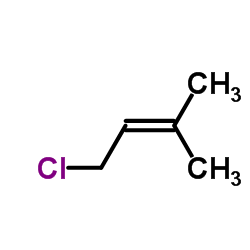
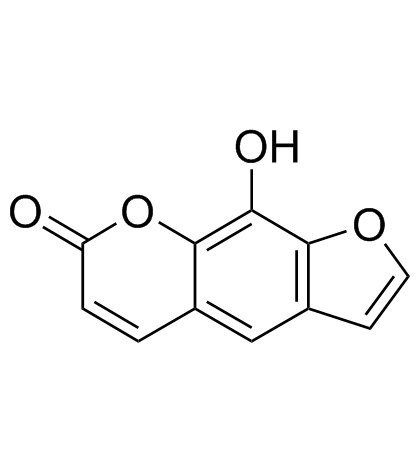


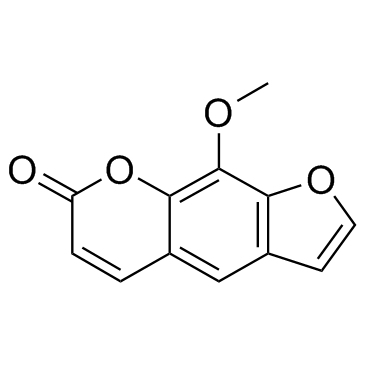
![2,3-dihydro-9-hydroxyfuro[3,2-g]chromen-7-one structure](https://image.chemsrc.com/caspic/353/68123-30-8.png)
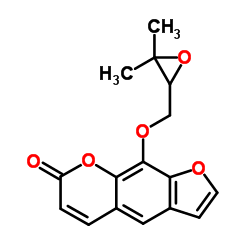
![9-(3'-Hydroperoxy-3'-methyl-1'-butenyloxy)furo[3,2-g][1]benzopyran-7-one structure](https://image.chemsrc.com/caspic/345/135366-52-8.png)
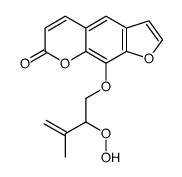
![9-hydroxy-4-prop-2-enylfuro[3,2-g]chromen-7-one structure](https://image.chemsrc.com/caspic/384/65161-79-7.png)
